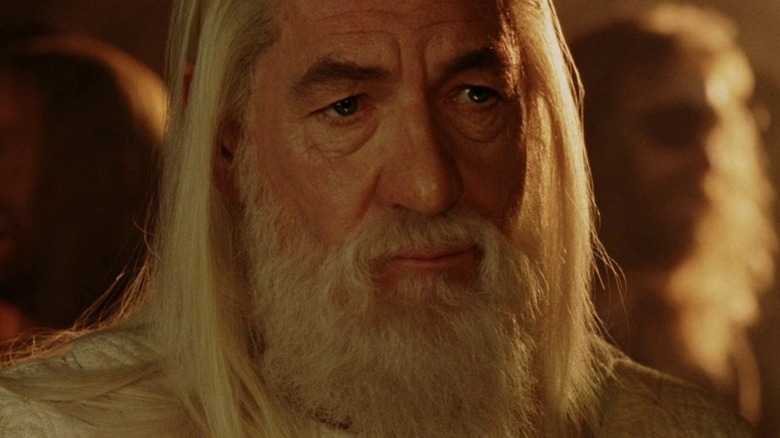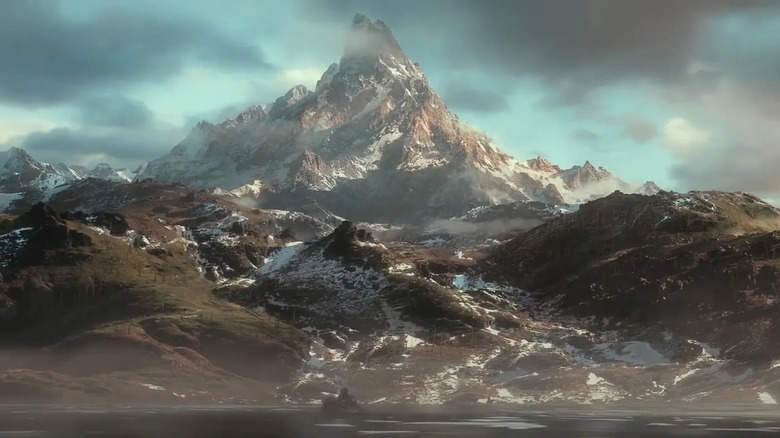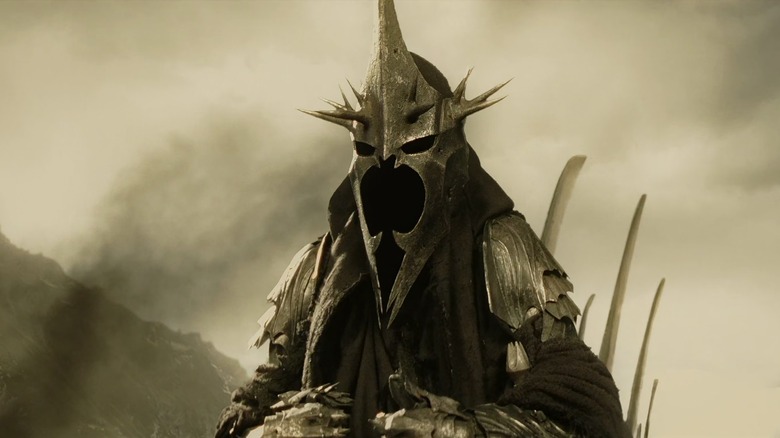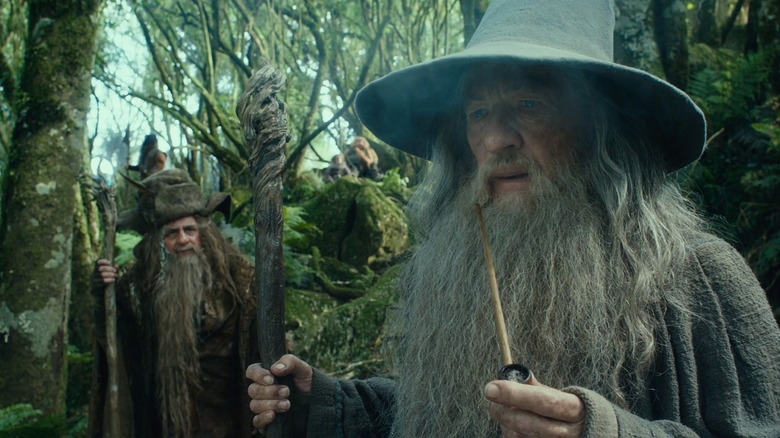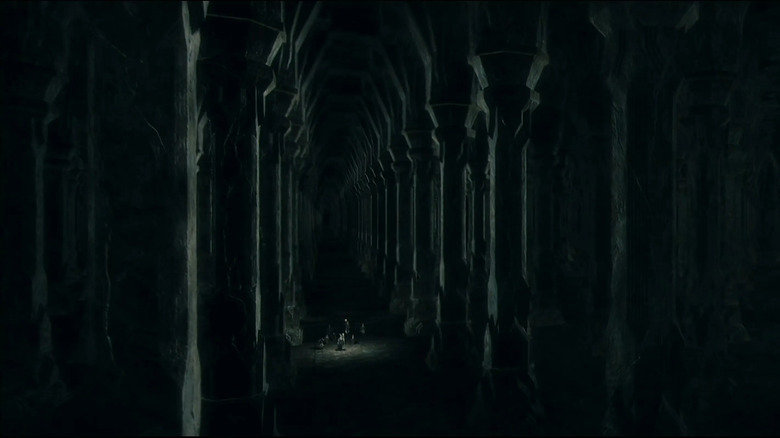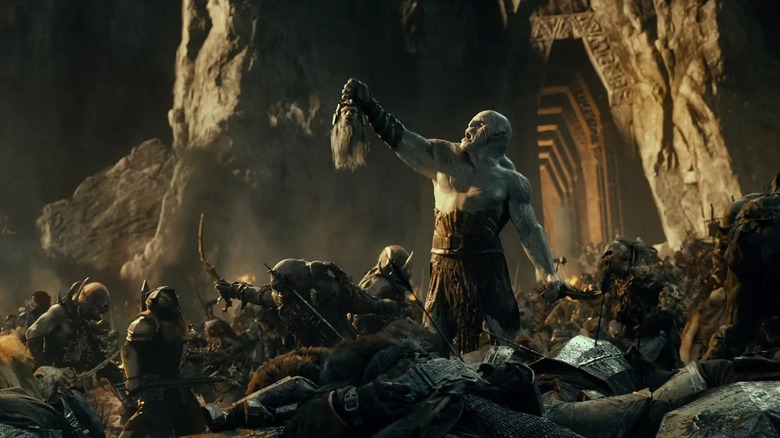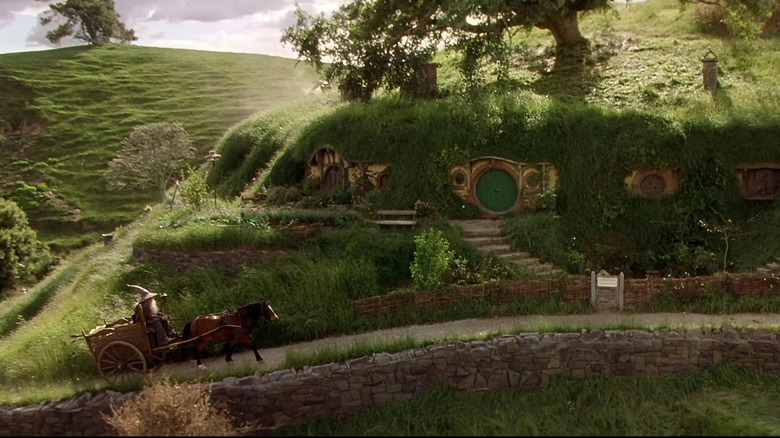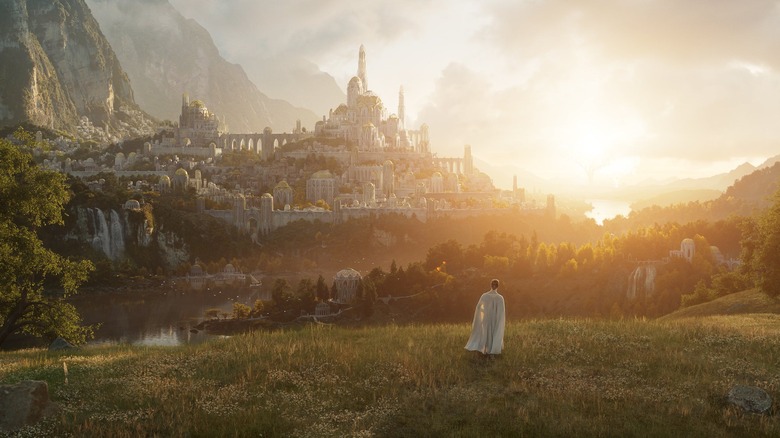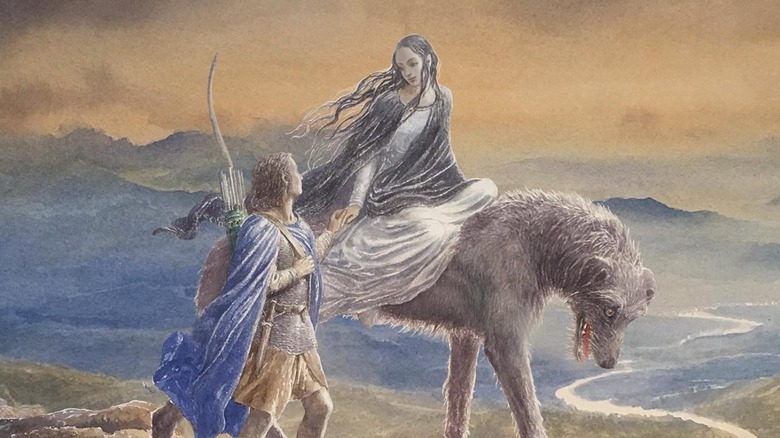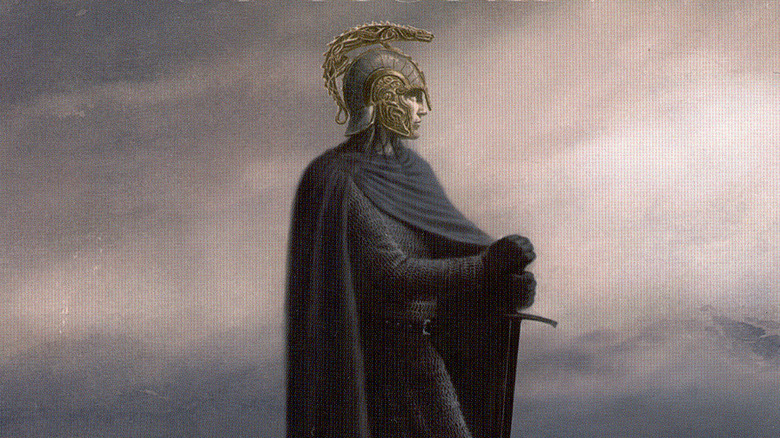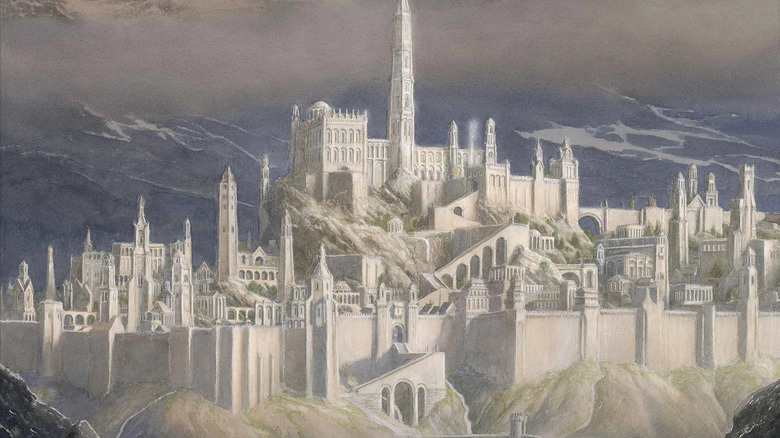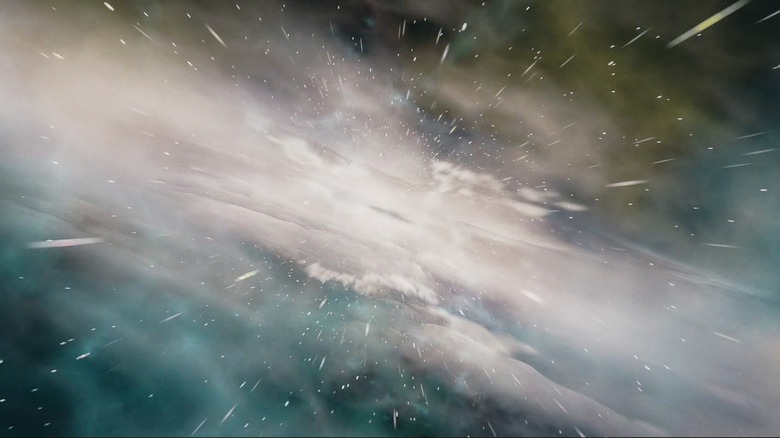The Lord Of The Rings Spinoffs Fans Want To See
On September 2, 2022, Amazon Studios will debut its hotly anticipated Middle-earth streaming series, "The Lord of the Rings: The Rings of Power." Series creators J.D. Payne and Patrick McKay revealed (via Deadline) that the show "unites all the major stories of Middle-earth's Second Age: the forging of the rings, the rise of the Dark Lord Sauron, the epic tale of Númenor, and the Last Alliance of Elves and Men."
Fans of J.R.R. Tolkien's legendarium will no doubt be thrilled to see the story of the Second Age played out on screen for the first time. They'll also know, however, that the history of Middle-earth spans far beyond the events of "The Hobbit," "The Lord of the Rings," or even "The Rings of Power." For example, in June 2021, New Line Cinema, the studio that produced Peter Jackson's iconic "Lord of the Rings" film trilogy, announced "The Lord of the Rings: War of the Rohirrim." This feature-length anime is set to follow Helm Hammerhand, the mythical king of Rohan, through his kingdom's wars during the late Third Age.
Clearly, there's an appetite for more tales from Middle-earth to be told, be it through feature film, long-form television, or animation. Luckily, there are countless other sagas and legends found within Tolkien's works, any of which could provide the source material for a thrilling adaptation of their own. These are the "Lord of the Rings" spin-offs that fans want to see.
Young Aragorn
Back in 2018, when "The Rings of Power" was still in the early days of pre-production, Tolkien fan site TheOneRing.net reported (via Nerdist) that the series would "open its first season centered on a young Aragorn." In a subsequent tweet thread, the site suggested that the "fabric" of Aragorn's story is "just so rich," and could easily feature such characters as Arwen, Gandalf, Elrond, and even Gollum.
Well, we now know that TheOneRing.net were way off the mark, but they were right about one thing: The adventures of young Aragorn would make for a fantastic television series. Much of the future king of Gondor's early life is told in the Appendices of "The Lord of the Rings," specifically in Appendix A's "The Tale of Aragorn and Arwen" and Appendix B's "The Third Age." In these stories, Aragorn falls in love with Arwen Undómiel; journeys into the wilderness as Chieftain of the Dúnedain; befriends Gandalf the Grey; serves the king of Rohan and the steward of Gondor in their struggles against Mordor; travels into the mysterious regions in the east and south of Middle-earth; and attempts to track down Gollum after his disappearance from the Misty Mountains.
As far as plot material goes, it doesn't get much more bountiful than this. Aragorn's quests through Middle-earth prior to "The Lord of the Rings" would provide the basis for multiple seasons' worth of a television or streaming series — and it doesn't exactly hurt that, according to Empire Online, Amazon Studios happens to own the rights to the Appendices in which they're contained.
The War in the East
In the extended edition of Peter Jackson's "Return of the King," Gimli laments to Legolas that the Rohirrim are lacking a legion of dwarves, "fully-armed and filthy," to aid them on their march to Gondor. "Your kinsmen may have no need to ride to war," Legolas tells him. "I fear war already marches on their own lands."
This is a reference to an incident that only appears in the Appendices to "The Lord of the Rings" — the Battle of Dale, a monumentally important conflict that takes place concurrently with the siege of Minas Tirith and the Battle of the Pelennor Fields. The two-week-long confrontation finds King Brand of Dale (grandson of Bard the Bowman) and Dáin Ironfoot (Thorin Oakenshield's successor as King under the Mountain) leading an army of men and dwarves against Sauron's Easterlings. In the course of the battle, both Brand and Dáin are killed, but their successors manage to prevent the Easterlings from breaking through towards Gondor and, after the Ring is destroyed, finally drive the enemy from their lands.
Both Dale and Erebor have already been depicted in live-action, in all three "Hobbit" movies, but the Battle of Dale has yet to warrant anything more than a brief mention in a single deleted scene. Still, this savage confrontation is rife with drama, from Brand and Dáin's last stand at the Gate of Erebor, to the darkest hours of the Easterling's siege, to the final push to free the mountain and its people. If New Line Cinema is eyeing an anime-based future for their portrayal of Middle-earth, they could do much worse than the Battle of Dale.
The Angmar War
Ask any Tolkien fan for the one chapter in Middle-earth's history they'd like to see adapted into live-action, and there's a pretty solid chance they'll answer: "The Angmar War."
Again, this story appears almost solely within the Appendices to "The Lord of the Rings." The war between the forces of Angmar, led by the Witch-King, and the mannish kingdom of Arnor, takes place over the course of some 600 years during the mid-Third Age. The conflict engulfs the region of Eriador in north-western Middle-earth, bringing together men and elves from every corner of the world — and even a few hobbits — to stand against Sauron's chief lieutenant. Before the end of the war, Arnor itself has been almost entirely annihilated, though the Free Peoples do eventually defeat the Witch-King and force him to flee to parts unknown. In fact, it's after the final great confrontation of the war, the Battle of Fornost, that the elf-lord Glorfindel infamously foresees: "Far off yet is his doom, and not by the hand of man will he fall."
The Angmar War is one of the darkest and most brutal conflicts in the history of the Third Age, but while the narrative is marked by death, disease, and destruction, it also exhibits the same sense of hope and unity that would emerge over a thousand years later, during the events of "The Lord of the Rings." Obviously, no single movie could possibly capture the sheer scale of the Witch-King's finest hour — but a long-form series would be another matter entirely.
Tales of the Istari
Otherwise known as the Istari, the five angelic Maia who come to Middle-earth as wizards play extraordinarily important roles in the fight against Sauron. These five wizards are: Saruman the White, Gandalf the Grey, Radagast the Brown, and the two Blue Wizards, Alatar and Pallando.
You probably know how things play out with Saruman and Gandalf; the former allows his ambition to get the better of him, falling into darkness before his own lackey unceremoniously assassinates him, while the latter ... well, he's Gandalf, isn't he? Radagast, meanwhile, settles down near Mirkwood for much of the Third Age, befriending the birds and beasts of the forest and keeping an eye on the growing shadow in Dol Guldur. He inadvertently leads Gandalf into Saruman's trap before subsequently helping him escape, and then pretty much vanishes from Middle-earth altogether. The Blue Wizards either venture eastwards to disrupt Sauron's plans or fail in their task and establish their own magical cults, depending which of Tolkien's writings you take as gospel.
Saruman, Gandalf, and Radagast arrive in Middle-earth around the year 1000 of the Third Age, while the Blue Wizards possibly show up sometime in the Second Age. This means that the Istari have been roaming for at least 2000 years before Frodo embarks on his quest, and, thanks to Tolkien's reticence on their history, readers have only their imaginations to suggest what they might have been doing during that time. Perhaps a spin-off of some kind, following the wizards on their adventures in the mortal world, could shed some light on the matter?
The legend of Khazad-dûm
The story of the kingdom of Khazad-dûm is long, glorious, and (literally) very dark. Best known as the setting for some of the most iconic moments in "The Fellowship of the Ring," the black pits of Moria once housed a thriving dwarvish realm, stretching far beneath the deep reaches of the Misty Mountains.
During the First and Second Ages of Middle-earth, the history of Khazad-dûm is one of peace, prosperity, and expansion. Even during the tumultuous days of the late Second Age, the Dwarrowdelf dwarves avert the ravages of war by shutting their gates and cutting themselves off from the outside world. Everything changes, however, during the Third Age. In the year T.A. 1980, the dwarves, obsessively mining the stores of Mithril contained within the mountain, accidentally awaken a Balrog. King Durin VI is killed during the demon's rampage, earning it the name "Durin's Bane," and the surviving dwarves flee their once-great kingdom. The dwarves attempt to retake Moria a couple of times over the next few hundred years, but it isn't until the coming of Durin VII, over 170 years after the events of "The Lord of the Rings," that they finally succeed.
The rise, fall, and rise again of the greatest dwarvish kingdom is a tragic and terrifying saga, but one that also goes overlooked by many of Tolkien's readers. No doubt, it would provide ample opportunity for a filmmaker to explore a darker, more horrific side of the author's world — and give the dwarves of Middle-earth some much-needed attention in the process.
The War of the Dwarves and Orcs
The fall of Moria briefly intertwines with another stage in the long journey of Tolkien's dwarves — one that would be equally gripping as its own adaptation. Fans have actually glimpsed a live-action portrayal of the War of the Dwarves and Orcs before: The climactic Battle of Azanulbizar appears in a flashback in "The Hobbit: An Unexpected Journey." But there's a whole lot more to this desperate struggle between dwarf and orc.
As told in the "Durin's Folk" chapter of Appendix A of "The Lord of the Rings," the war begins when Moria's orc-chieftain Azog (also a familiar face to anybody who's seen the "Hobbit" movies) murders Thrór, the exiled King under the Mountain. Thrór's son, Thráin, marches to war to avenge his fallen father, amassing a great army of dwarves from all across Middle-earth. The dwarves plunder and pillage down the breadth of the Misty Mountains; Tolkien writes, "Both sides were pitiless, and there was death and cruel deeds by dark and by light."
After six years of warfare, much of which takes place underground, the two sides clash outside the East-gate of Moria, in what is later known as the Battle of Azanulbizar. Here, Dáin Ironfoot kills Azog (sorry, Peter Jackson) and the orcs are routed, though they stop short of entering Moria for fear of Durin's Bane. Worse still, the vengeance of the dwarves comes at a terrible cost, and countless dwarvish lives are lost during the war's final battle.
While the War of the Dwarves and Orcs might only constitute one part of a wider Moria project, it could easily stand as its own story — and one for the "Hobbit" fans, in particular.
Hobbits of the Shire
A spin-off film or series set within the boundaries of the Shire could take almost any form. It might offer a pleasant and comedic exploration of the lives of hobbits during peacetime, with few dramatic stakes higher than a drunken expedition to Farmer Maggot's crop or a dispute over an elderly relative's inheritance. It could go a little darker, too, perhaps even bringing the Scouring of the Shire to the big (or small) screen for the very first time.
To really show the hobbits in a brand new light, however, you'd have to turn to the war between the hobbits and orcs that ends with the Battle of Greenfields. A few hundred years before "The Lord of the Rings," bands of orcs from the Misty Mountains invade Eriador. While the Dúnedain rangers manage to keep most of them at bay, one group, led by the goblin king Golfimbul, successfully enters the Shire. Led by Bandobras Took, the hobbits meet the orcs in battle at the Greenfields, and it's during the ensuing fracas that — as readers of "The Hobbit" will tell you — the game of golf is invented, after Bandobras knocks Golfimbul's head into a nearby rabbit-hole.
In so many of Tolkien's stories, war is shown to be very much the province of men, elves, dwarves, and orcs. A short series, animation, or even a film that sees Bandobras and his hobbits rise up to defend their homeland would shine a whole new light on the Shire and its inhabitants.
The Darkening of Valinor
Stanley Kubrick once famously claimed that "The Lord of the Rings" was "unfilmable." Tolkien's biographer, Humphrey Carpenter, said the same thing years later. Indeed, until the release of Peter Jackson's "Lord of the Rings" trilogy, many would have agreed with them.
But if "The Lord of the Rings" is the unfilmable, then "The Silmarillion" is the utterly impossible. Tolkien's colossal history of Arda — and particularly the "Quenta Silmarillion," which covers everything from the making of the world to the end of Middle-earth's First Age — is a tale of gods, demons, magic, and brutality on an almost incomprehensible scale. And the so-called Darkening of Valinor is a particularly magnificent and dreadful affair from Arda's Elder Days.
In this era, the Blessed Realm of Valinor, far over the sea from Middle-earth, is lit by the glow of the Two Trees, Telperion and Laurelin. Morgoth, the Dark Lord, allies with the evil spider-spirit Ungoliant to pass into Valinor and destroy the Two Trees, an atrocity that plunges the Undying Lands into darkness. Along the way, Morgoth steals the mythical jewels known as the Silmarils from the elf-king Fëanor; consumed by their desire for vengeance, Fëanor and his Noldor elves murder their kinsmen, steal a fleet of ships, and set out to make war on Morgoth on the distant continent of Beleriand. Finally, at the end of the Long Night, the godly Valar use the last fruit and flower of the Two Trees to create the sun and the moon.
Dramatic? Of course. Epic? Absolutely. Unfilmable?
Who knows?
Beren and Lúthien
During his lifetime, J.R.R. Tolkien composed three stories, set during the "Quenta Silmarillion," that were written to be enjoyed as complete works in and of themselves, and which did not require the reader to have an understanding of the wider mythos. These are known as the three "Great Tales" of the Elder Days of Middle-earth, and by far the most famous of them all is the tale of Beren and Lúthien.
Otherwise known as the Quest for the Silmaril, the narrative revolves around the forbidden romance between Beren, a man, and Lúthien, the daughter of the elf-king Thingol. When their love is exposed, an enraged Thingol jokingly promises that Beren will be allowed to marry Lúthien if he enters Morgoth's fortress of Angband, plucks a Silmaril from his crown, and brings it back to the elves of Doriath. To his surprise, Beren agrees, quickly setting out to fulfill his task.
This story was very dear to Tolkien's heart; on his gravestone, he is named as "Beren," while his beloved wife, Edith, is named as "Lúthien." Perhaps that's why the tale of Beren and Luthien arguably feels like the author's finest work, swathed in the near-palpable passion and devotion he clearly felt towards his world. Certainly, the Lay of Leithian, an incomplete poetic rendition of the tale, contains some of his most beautiful and affecting writing. No part of Tolkien's vast legendarium is more deserving of a faithful adaptation.
The Children of Húrin
The second of the Great Tales is "The Children of Húrin." Although the exploits of Túrin Turambar can be found in a number of Tolkien's works, the most complete telling exists as a novel edited by Christopher Tolkien and released in 2007.
If "Beren and Lúthien" is Middle-earth's romantic fairy tale, then "The Children of Húrin" is its Greek tragedy. Túrin is the son of Húrin, a great lord of men who attracts the wrath of the Dark Lord. Captured in battle and chained to the mountains above Angband, Húrin is punished by Morgoth by way of a family curse that, wherever Túrin and his sister, Nienor, might go, "evil shall arise. Whenever they speak, their words shall bring ill counsel. Whatsoever they do shall turn against them. They shall die without hope, cursing both life and death."
Sure enough, Morgoth's curse comes to pass, and "The Children of Húrin" follows Túrin as he roams across Beleriand — inadvertently bringing misery and destruction to everyone he meets. This culminates in a final showdown with Glaurung, the first of Morgoth's dragons. We're not kidding about the "Greek tragedy" thing, either: Túrin's life is steeped in torture, murder, incest, and suicide. It's a long, long way from Bilbo's birthday party.
Should "The Children of Húrin" ever be brought to the small or silver screen, it would likely be the bleakest, most gruesome adaptation of Tolkien's works to date — and perhaps the most riveting, too.
The Fall of Gondolin
"The Fall of Gondolin" is the last of Tolkien's Great Tales. Recounting one of the most important and bloodiest battles of the First Age, the story begins as Morgoth finally discovers the location of the hidden Noldor city of Gondolin, thanks to the treachery of a lovelorn elf named Maeglin. The armies of Angband, consisting of orcs, wolves, dragons, and Balrogs, swiftly descend upon the city, beginning a desperate siege that ends, eventually, with its total destruction. Only a handful of survivors escape into the mountains.
As it happens, "The Fall of Gondolin" holds the distinction of being the first work of the Middle-earth legendarium ever conceived by Tolkien, having been composed in his head while on sick-leave from the British Army in 1917, just after fighting in the Battle of the Somme. The author's experiences in World War I had a direct impact on his telling of the siege; as Tolkien biographer John Garth writes on his website, "The worst and best of what he had seen in the Somme soldiery were embodied in the brutal goblin attackers and the elvish defenders, valiant against hopeless odds. Among the dragons and demons in the assault are bizarre machine-like monstrosities which hurl fire or from which troops debouch: the archaic prose might be describing a tank — then newly deployed on Tolkien's stretch of the Western Front — as seen through medieval eyes."
Middle-earth's deadliest siege meets mankind's Great War — who wouldn't want to see that told in all its terrible glory?
The War of Wrath
The world-changing conflict known as the War of Wrath may not have been one of Tolkien's Great Tales, but it nevertheless rounds off the "Quenta Silmarillion" in suitably epic fashion.
Before the battle begins, things are going pretty woefully for the Free Peoples of Middle-earth. Morgoth's forces have spread across Beleriand, having sacked Gondolin and the other great elven cities and driven the survivors towards the sea. Worse still, the sons of Fëanor, desperate to claim the sole Silmaril that has been stolen back from Morgoth (you can thank Beren for that one) attack their kin at the Havens of Sirion. The half-elf hero Eärendil, however, escapes with his life — and the sacred jewel. Eärendil sails his ship to the shores of Valinor, begging the Valar to come to Middle-earth to wage war against Morgoth. Against all odds, the Valar actually agree, and gather a host of Valar, Maiar, and elves, the likes of which is never seen again in Middle-earth.
The Host of the Valar engages in a decades-long battle against the forces of Morgoth, in which the Dark Lord's armies are utterly annihilated, the land itself is broken and sundered, and — just for good measure — Eärendil takes to the skies in his magical ship to fight Ancalagon the Black, the greatest dragon ever known. The war ends with a catastrophic defeat for Morgoth, who is struck down by the Valar, bound in chains, and cast into the Timeless Void.
Say it with us, now: "Unfilmable."
